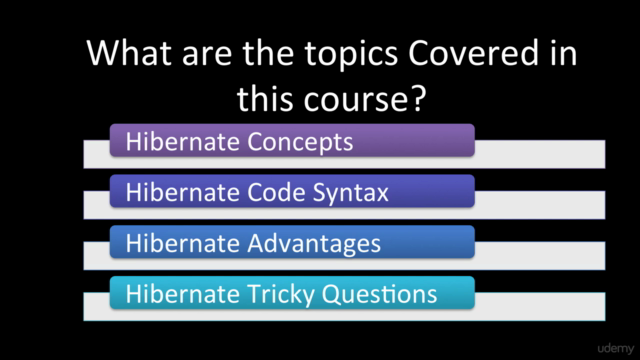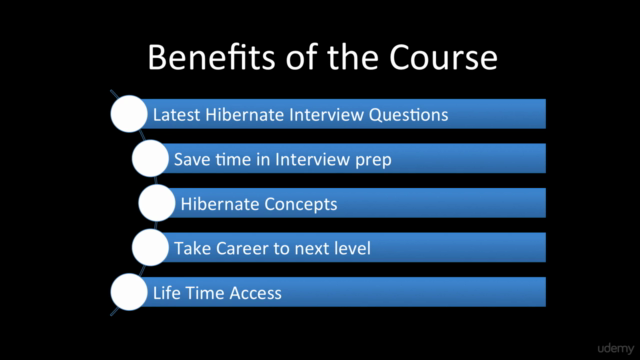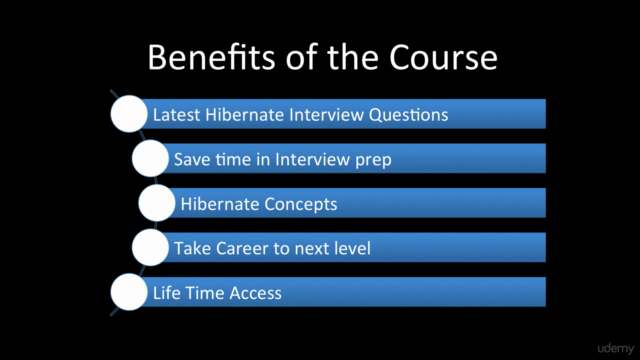Hibernate Interview Questions Preparation Course

Why take this course?
-
Key Characteristics of Hibernate:
- Object-Relational Mapping (ORM): Hibernate maps Java objects to database tables and vice versa, simplifying data persistence.
- SQL-like Query Language: HQL provides a more intuitive way to retrieve and manipulate data from the database without writing raw SQL.
- Caching: It can cache frequently accessed data to improve performance and reduce load on the database server.
- Transactions: Hibernate manages transactions, ensuring data integrity and consistency.
- Query Results Binding: Maps query results to Java objects or collections of objects easily.
- Rich Interface for Database Operations: It provides various APIs for fetching, updating, deleting, and retrieving data in a generic manner.
-
Core Interfaces of Hibernate Framework:
Session: The primary interface used to interact with the persistent object.Transaction: Used to manage transactions in aSession.QueryorCriteria: Used to query and retrieve data from the database.SessionFactory: Builds aSession, which is used to interact with the database.Configuration: Configures the Hibernate session factory.
-
Mapping Columns to Java Class Properties:
- Using XML mapping files (
.hbm.xml) or annotations, you define the mapping between the Java class properties and the database table columns. - The mapping can specify column names, relationships, table-specific details, etc.
- Using XML mapping files (
-
Mandatory Mapping File Extension:
- Traditionally, Hibernate mapping files have the
.hbm.xmlextension, but this is not strictly mandatory with modern annotation support.
- Traditionally, Hibernate mapping files have the
-
Creating a SessionFactory in Hibernate:
- Read the configuration file (XML or properties).
- Create a
Configurationinstance. - Add the resource mappings (if using XML).
- Build the
SessionFactoryfrom the configuration.
-
Use of POJO in Hibernate:
- POJOs (Plain Old Java Objects) are used because they are simple, portable, and can be easily mapped to database tables without needing to extend specific classes or implement specific interfaces.
-
Hibernate Query Language (HQL):
- HQL is a high-level query language similar to SQL but designed for Java objects. It allows users to write queries using the domain model rather than the database schema.
-
Calling a Stored Procedure:
- You can call stored procedures using the
Sessioninterface by creating a custom SQL query or using theCallbackinterface for more complex operations.
- You can call stored procedures using the
-
Criteria API in Hibernate:
- The Criteria API provides a powerful way to programmatically specify criteria for querying persistent entities without writing HQL strings.
-
Use of HibernateTemplate:
HibernateTemplateis an alternative to theSessioninterface, offering a consistent set of operations for simpler applications or as a learning tool. It's deprecated in favor of theSessionAPI due to its limitations and lack of certain features.
-
Viewing SQL Code Generated by Hibernate:
- Set the
hibernate.show_sqlproperty totruein the configuration file or use logging interceptors like SLF4J with appropriate log level for debugging.
- Set the
-
Different Types of Collections Supported by Hibernate:
List,Set,Map,Bag, andMultimap. Hibernate 5 introducedCollectionas a unified collection abstraction that is equivalent toListandSetcombined.
-
Difference between session.save() and session.saveOrUpdate():
session.save(object)persists a new transient object.session.saveOrUpdate(object)saves the state of a persistent or transient object, which means it will save a new object if it's not already associated with the session, or it will update an existing one if it is.
-
Advantages of Hibernate over JDBC:
- Abstraction from SQL and database access.
- Increased productivity due to ORM capabilities.
- Improved maintainability due to less code and clearer separation between logic layers.
- Enhanced performance due to caching and batch operations.
- Database agnosticism, as it can work with different databases with minimal changes.
-
Transactions:
- Hibernate provides a Transaction API for managing transactions in a
Session.
- Hibernate provides a Transaction API for managing transactions in a
-
Rich Object-Oriented APIs:
- Hibernate offers a rich set of object-oriented APIs to interact with the database, such as Criteria and EntityCriteria for querying and Envers for auditing.
-
Caching:
- Hibernate has both first-level and second-level caches to improve performance by reducing the number of queries executed against the database.
-
Interactive SQL Logging:
- Hibernate allows you to log the actual SQL statements being generated, which is useful for debugging or understanding what is happening under the hood.
-
Fetch Profile and Result Transformer:
- Fetch profiles allow you to specify fetching strategies (eager, lazy) for associations.
- Result transformers enable you to post-process query results according to certain rules.
-
JPA vs Hibernate:
- Hibernate is an implementation of the Java Persistence API (JPA). JPA provides a standard API for data persistence, which can be used independently of Hibernate. However, Hibernate was the reference implementation that inspired the development of JPA.
-
Envers:
- Envers is an auditing extension for Hibernate that supports different types of auditing such as historical and versioned data management.
-
Lazy Initialization:
- Hibernate supports lazy initialization, which defers the loading of data until it is explicitly requested, to improve application performance by reducing the initial load on the database.
-
Batch Operations:
- Hibernate provides support for batch operations to execute multiple insert, update, or delete statements in a single transaction to optimize database performance.
-
Internationalization and Localization:
- Hibernate supports storing locale-specific data and generating SQL queries suitable for different locales.
-
Integration with Spring Framework:
- Hibernate integrates seamlessly with the Spring Framework, leveraging aspects like dependency injection, transaction management, and aspect-oriented programming to enhance modularity and manageability of applications.
-
Hibernate Search:
- Hibernate Search is an extension for full-text search capabilities on top of Hibernate's data access engine.
-
Hibernate Validator:
- Hibernate Validator provides powerful constraint validation for JavaBeans, leveraging the Java EE Bean Validation API.
Course Gallery




Loading charts...